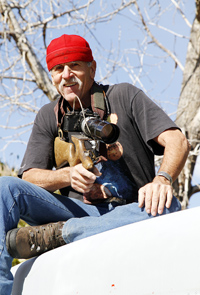Some photographers "take" pictures, waiting for the "decisive moment" to capture an evocative image. Steve Snyder also "makes" photographs "like a painter draw'n a brush on canvas ..." he writes in an artist's statement. "Try'n evoke initial wordless deep emotional connection, by showing image essence of balanced wholeness ..."
Snyder is a passionate artist with a mystical streak, capable of saying many things at once. He won a poetry slam at Iconoclast Books during the early 1990s. He calls poetry "thinkin' about thinkin'" and it usually contains an urgent message to save planet Earth:
"It's time to wake up/ look up/an' grow up/ it's time to listen up/think up/an' stand up ... it's MY turn to group up, team up/an' HUMAN UP," he writes.
Born in Bodega, Calif., in 1942, Steven Mark Snyder sometimes rode a horse to grade school classes in a schoolhouse featured in Alfred Hitchcock's 1963 film "The Birds." When his mother was a child, she rode in the rumble seat of a Model-A Ford down the California coast to Big Sur.
These days, Snyder lives in Hailey where he serves in a local mentoring program and participates in the Wood River Valley Men's Group, affiliated with Mankind Project International, building empowerment by reclaiming the "sacred masculine."
He uses a collection of Frisbees to test wind currents in the mountains.
Snyder studied forestry and landscape architecture at Oregon State University before joining the U.S. Army Airforce, helping to operate nuclear-tipped Nike Hercules missiles by computer. In 1968, he left the military and motorcycled around Europe before catching a tramp steamer back to the United States. He traded his motorcycle for a camera, intent on becoming a photographer.
"Documenting the natural world gave my existence meaning," says Snyder, who, early in his career, knocked on the door of legendary photographer Ansel Adams in Carmel, Calif. Snyder was encouraged when Adams slowly looked through his portfolio and said, "You've got some real gems here."
In 1970, Snyder hit the road, heading east from California in an MGB Roadster (he has owned 18 British sports cars, including a tri-carb Austin Healey 3000, and a bug-eye Sprite), with a pair of Head Standard 220 skis on the roof. He stopped in the little town of Ketchum, what he calls "downtown Idaho," and never left.
"In 1975, I quit my day job. I was going to be a black-and-white fine-art photographer alone with the primal
world, communicating, talking elk, porcupine and eagle-ese."
He was a founding member of the Sun Valley Gallery Association, along with Gail Severn and Barbie Reed, and had four galleries in Ketchum, selling "thousands and thousands" of his black-and-white photographs to buyers around the world.
"I even have one in Lapland," he says.
Snyder still has a few prints from his "wet" darkroom, printed on archival Hahnemuhle paper, made by a company that has been in business since 1584.
"Ansel Adams would have liked that," he says.
But he closed his last gallery six years ago when he couldn't pay the $4,000-per-month rent.
"I couldn't sell enough photographs to pay for the time to be creative," he says.
His galleries were filled, not only with his photographs, but with artifacts of what he calls "the rest of the best of the West," including old stoves and ore carts, wagon wheels from the Duck Valley Indian Reservation and cylinders of rock from core samples drilled by miners.
"The core samples are geologic timelines," Snyder says. "They go back to when three-toed horses evolved in North America, and way, way back before that."
One of Snyder's more well-known photographs is of a cat sitting on the rafter of a fallen-down shack, just out of reach of two barking dogs. He took the picture in Lake Creek north of Ketchum where he had an acre of land on a small creek, before many multi-million-dollar homes were built there. Another features a wounded eagle in snow.
"It flew away down a canyon two days later," Snyder says.
But he considers one of his most important photographs to be a collage of an image of Earth as seen through a window in a cabin. Earth is on the inside of the cabin, lit by a kerosene lamp.
"Their home is Earth. They are being supported by supporting its existence. Why is observer, human me, standing outside?"
The cosmic perspective that informs Snyder's art began when he started writing poetry while spending summers on three acres he owned beside a rapid on the Big Lost River in the shadow of Mount Borah many years ago. He lived in a sheep wagon with a glass-domed ceiling.
"I got so I could tell the time of night by the position of the Big Dipper in the sky," says Snyder, who gave himself a new name, GUS2, several years ago, in light of certain revelations he had about his own position in the universe.
"G stands for the Galaxy Milky Way. U means I am surrounded by the Universe. S means I am my own spirit. 2 means also."
In one of his poems, he ponders his place in the universe, "a part of this Great Splendor of Mystery," and where and when it all began.
"I don't call it the Big Bang. I call it the Big Beat Heart Start," he says.
Snyder can be reached at stevesnyderphotos@gmail.com.


 Steve Snyder looks for the right angle from atop his Jeep.
Steve Snyder looks for the right angle from atop his Jeep.



































